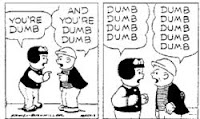Good topic, but the invitation was enveloped in some rhetoric suggesting that the most troubling thing about this trend wasn’t just the lack of incentives for young people to pursue public service jobs but that it’s keeping the “the best and the brightest” from doing so.
Correct me if I’m wrong, but from where I sit, it seems as if the “best and brightest” are pretty much becoming the only ones able to pursue public service careers. And what’s wrong with wanting those folks in our ranks?
Nothing---if we're using “best and brightest” to connote people with exceptional skills, intelligence, passion, and tenacity. But it seems that increasingly, the phrase is being used as a code for credentials, educational pedigree, social capital, and financial connections.
And I've experienced some of this myself as a former program officer with an older foundation. Not surprisingly, most of the young people who had entrée to its coffers were the those who've had access to an Ivy League (or equivalent) education; parents who paid their rent so they could get (or did get) the "good" internships; and/or friends or family members who were political figures, academics at other Ivy League schools, famous media people, and others comprising what David Brooks would call the ruling class.
More disconcerting was that they tended be viewed by adults as "the best and the brightest," which had less to do with the merit or experience of these young people and more with the connections and capital of their parents or others with the influence to propel these folks over other the heads of other worthy (and less entitled) candidates who were equally (and sometimes more) qualified.
Yes, older and more established institutions are more likely to adhere to a white-gloved tradition. But is the latter trickling out to less-established nonprofits and to the sector, overall? Are we becoming just as obsessed as the larger culture on the famous, the connected, and the rich? Nonprofit conferences and events showcase individuals whose bios, full of elite credentials, are proudly proclaimed. Young people held up as the best examples of nonprofit leadership are often those who’ve had access to financial, social and educational connections. At a recent conference, one brave soul stood up and asked whether there were any national service initiatives that had been launched by "anyone not from Harvard, Yale or Princeton." Of course there are, but they're sometimes overlooked because they lack the cachet that an Ivy League rubric immediately bestows.
So what's wrong with this? Nothing, if one believes that educational pedigree, credentials and social capital are inherently superior to experience, hard work, skills, tenacity, and one’s own “gumption,” as a young friend of mine called his own rise to success in the nonprofit sector (and who had little credentials of which to speak, he noted happily). But how much is "gumption" valued? When it comes down to a choice between my friend and a recent Harvard graduate whose parents are Stanford professors, New York Times reporters, or former White House staff members, whom do you think is going to get first dibs on the job... the grant... or the opportunity?
That's a thorny issue that hasn't been discussed much in nonprofit forums because it runs right up against the values that many in that sector say they hold dear. And it makes people understandably uncomfortable, especially those in nonprofit leadership positions whose rise to prominence may have had less to do with merit than with their pedigree or personal connections.
So what do we do about it? We can start by recognizing that a cultural obsession with last names, pedigree, and/or social capital doesn’t have to be one that we embrace, but rather, challenge. We can hire people on the basis of their experiences and skills, rather than on who their parents are or where they went to school. In the midst of all the accolades being bestowed on our leaders, we can ask, “what have they actually done to deserve these?” And, perhaps most importantly, we can ask what obstacles, if any, has this person endured or overcome and how has that made them a stronger, smarter, and/or ethical person?
As Booker T. Washington once wrote, "Success is to be measured not so much by the position that one has reached in life as by the obstacles which he has overcome." Perhaps that's the criteria we should think about using for "the best and brightest" in the nonprofit sector.


















